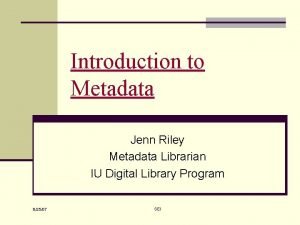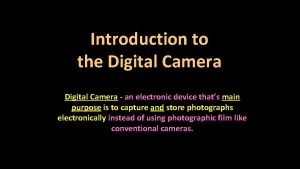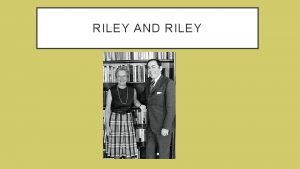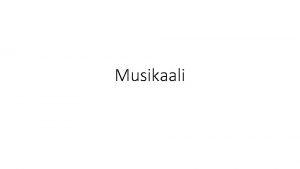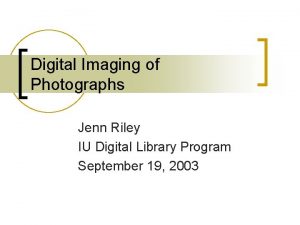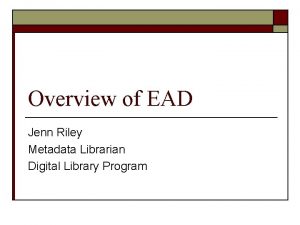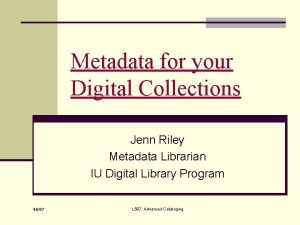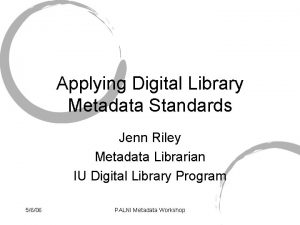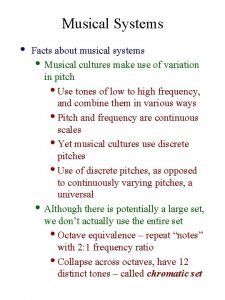Digital Image Capture of Musical Scores Jenn Riley


















- Slides: 18

Digital Image Capture of Musical Scores Jenn Riley, Indiana University Digital Library Program Ichiro Fujinaga, Mc. Gill University

Outline n n n Why is this necessary? Defining the purpose of scanning Master file specifications ¡ ¡ ¡ n n Resolution Color reproduction and bit depth Master file formats Web delivery Printing

Why Is This Necessary? n n Successful information retrieval depends on quality data Musical scores are visually complex Digital imaging standards do not explicitly cover musical notation so the principles they present must be adapted Master digital files should be adequate for many different uses

Defining the Purpose of Scanning n Artifactual n Content-based

Master File Specifications n n What is a master file? Resolution Color reproduction and bit depth Master file formats

What Is A Master File? n n n For long-term storage and future migration Used to create derivatives for specific purposes Captures all “important” information from the analog original

Resolution n. One method*: calculate necessary resolution to capture the smallest detail with three pixels r = 3 px /. 039 d for. 1 mm detail: r = 3 /. 039(. 1) r = 769. 23 ppi * adapted from Kenney, A. , and O. Rieger. 2000. Moving Theory into Practice. Mountain View, California: Research Libraries Group. 46 -47.

Resolution, cont’d. n 300 dpi n 600 dpi

Resolution, cont’d. n 600 dpi scans generally capture all relevant detail on all but the smallest printed scores. Some examples can be found at http: //www. dlib. indiana. edu/~jenlrile/ismir 2002/resolution/. n Bottom line: resolution recommendations from best practices are a starting point, not a complete answer

Color Reproduction and Bit Depth n n Color may be necessary for artifactual image capture, but probably won’t be for content-based capture 8 -bit grayscale is preferred over bitonal capture, even for content-only purposes

Bitonal vs. 8 -bit Grayscale n Bitonal n 8 -bit Grayscale

Master File Formats n n Open, non-proprietary If compression is used, it must be lossless Digital imaging best practices overwhelmingly recommend uncompressed TIFF, even though it is not a true open standard PNG may be an emerging alternative, but there is no uncompressed version

Web Delivery – Pixel Dimensions n n Due to the wide range of sizes of type and importance of small details, fixed pixel dimension images are not appropriate for delivery of score images 100 -200 dpi files, based on original page dimensions, with attention to resulting image size fitting on screen may be a better approach. Some examples are at http: //www. dlib. indiana. edu/~jenlrile/ismir 2002/webdelivery/.

Web Delivery – File Formats n Formats viewable with standard browsers and common plug-ins desirable ¡ ¡ n JPEG, GIF, PNG, PDF meet this requirement TIFF, Dj. Vu do not IR system considerations may also affect choice of formats ¡ Integration with other forms of musical representation: notation files, sound, annotation tools, etc.

Printing n n n Necessary capability for performance and study Depending on original page size, 250400 dpi files should fit on 8. 5” x 11” or A 4 paper and provide readable results Generally there will be no need for grayscale or color images for printing

Printing, cont’d. n n PNG and TIFF are perhaps best formats Bitonal PNG files smaller at lower resolutions, but Group 4 compressed bitonal TIFFs are smaller at higher resolutions Original page size 8. 5”x 11” PNG TIFF (Group 4) 800 dpi 329 KB 192 KB 400 dpi 183 KB 146 KB 250 dpi 90 KB 96 KB 200 dpi 64 KB 71 KB 100 dpi 25 KB 38 KB

More Information n Supporting materials can be found at: http: //www. dlib. indiana. edu/~jenlrile/ismir 2002 n A list of digital imaging standards and best practices can be found at: http: //www. dlib. indiana. edu/dmic/general/standards. html

Contact Information n Jenn Riley, Indiana University Digital Library Program, jenlrile@indiana. edu n Ichiro Fujinaga, Mc. Gill University, ich@music. mcgill. ca
 Jenn riley mcgill
Jenn riley mcgill Jenn riley metadata
Jenn riley metadata Thenounproject
Thenounproject Riley riley modeli nedir
Riley riley modeli nedir Typologies are nominal composite measures
Typologies are nominal composite measures Brooke latulippe
Brooke latulippe Image transform in digital image processing
Image transform in digital image processing Optimum notch filter in image processing
Optimum notch filter in image processing Image compression model in digital image processing
Image compression model in digital image processing Image segmentation in digital image processing
Image segmentation in digital image processing Analog image and digital image
Analog image and digital image Objective fidelity criteria
Objective fidelity criteria Image sharpening in digital image processing
Image sharpening in digital image processing Image geometry in digital image processing
Image geometry in digital image processing Fundamental steps in digital image processing
Fundamental steps in digital image processing Digital image processing
Digital image processing Image geometry in digital image processing
Image geometry in digital image processing Noise
Noise Is a camera an electronic device
Is a camera an electronic device

